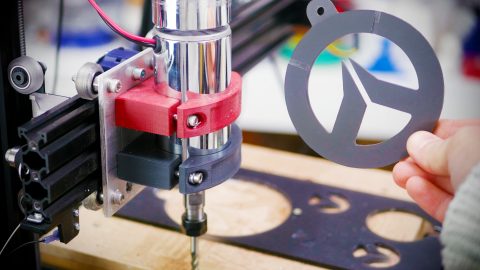There are some fantastic materials available for 3D printing today – here’s the ultimate test for them!
When I tested the Markforged Mark Two 3d printer and started using the continuous carbon, glass and especially the Kevlar fiber inlays, there was that one question that kept bugging me: Could we actually make 3D prints that are bulletproof? And how well do those normal materials like PLA, ABS and PETG compare?
Could we actually make 3D prints that are bulletproof?
So to be honest, I had no idea how much these 3D printed, plastic parts would be able to withstand. But that’s easy to test out! I started with these 50mm or 2” diameter discs. At first, I only made them 3mm or about ⅛ of an inch thick, since just as a rough estimate, I wanted to test these with an air rifle first before moving on to the big guns. So I called up a friend and we set up a quick slow motion rig, using this old Casio camera, which does do a 1000 frames per second, but, well. You can sorta see what’s going on, but not much more. I printed these test parts with a few different materials that scored pretty well in the Filaween testes, that is regular old PLA and DAS FILAMENT PETG, I’ll bring in a few more standard materials later. I also printed a test part on the Mark Two that was completely filled with continuous glass fiber and one that used Kevlar. All of these were 3mm thick, and I was hoping that would be enough to stop the air rifle’s pellet, which has an energy of less than 7.5 Joules. Relatively speaking, that’s not a lot of energy, but you definitely don’t want to get hit by these. I thought the PETG would at least stand a bit of a chance, but neither it nor the PLA seemed to slow the pellet down at all. Kinda disappointing, I really thought these would be a bit tougher. But once we bring in the Markforged parts, things start looking quite a bit better. Because neither the Glass fiber nor the Kevlar-filled parts cared too much about being shot at. Yeah, they ended up with a bit of a dent, but the Pellet didn’t even scratch the Nylon surface of the parts. Remember, these are all 3D-printed fiber on the inside, and only a thin layer of the Onyx Carbon-fiber-filled Nylon on the surface. So that was promising! But as a video guy, the image from that Casio camera was driving me nuts, so after a quick call with Mark 3D, they agreed to sponsor the costs of this video, which did include renting a Sony RX100, which still does 1000 frames per second, but the image just looks so much better. I also asked them to print a few more fiber-filled parts since I did have to return the Mark Two in the meantime, and they printed a bunch more parts in Onyx Nylon and a few filled with that sweet Kevlar and glass fiber.
Obviously, I would have to step up the material thickness for all of these parts and particularly the regular plastics to stand any sort of a chance against a .22 and .45 caliber bullets.
I also needed some sort of a holder for these parts, and probably as more of an excuse to use the converted CNC mill, I made this part from aluminum. But as it turns out, a converted 3D printer is not the best choice for doing heavier work like this. Who would have thought?

I also printed a bunch more parts, going for 5, 10, and 20mm thick discs, using the translucent green DAS FILAMENT PLA, bright green rigid.ink PLA Plus+, which is an impact-modified type and if there’s anywhere that property would shine, It would be with actual impacts. I also used the brown DAS FILAMENT PETG again and threw in REC ABS in grey, since one of the core properties of ABS is, again, that impact resistance. It ended up being quite a bit of material with two full sets of all these pucks, the largest ones are almost 50 grams of material each.
And then it was time to head to the shooting range. They’ve not had a major accident on this range so far, and I didn’t want to have caused the first one, so we decided to scrap the aluminum holder and went for wood and duct tape instead. Still worked, not quite as fancy, but probably a bit safer and if we actually hit the wood, it’s probably going to look pretty good on camera, too!
First round: The .22 small-bore. While these are the smallest common caliber for a firearm, they already have over 20 times as much energy as the air rifle, so they’re definitely no joke. And almost as expected, none of the smaller 5mm thick parts stood any sort of a chance, even the fiber reinforced parts didn’t manage to stop the .22 bullet. However, when I taped the old 3mm part back on, that was already bent from the air rifle, it did stop the bullet, but it was backed up against the wood, while the other parts were only supported at their edges. Moving on to the 10mm thick parts, we can start seeing how the different materials perform. The PLA just gets a fairly clean hole stamped out, and the same for the impact-modified PLA Plus+ and ABS. However, PETG completely shatters into bits, it doesn’t stop the bullet, but as it breaks, we can see that it doesn’t break along layer or extrusion lines, but into mostly random bits, so once again we can confirm that the 3D prints with copolyesters make for parts that don’t differ too much in strength from mass-produced, injection-molded parts. The Markforged Onyx Nylon part shows almost the opposite, with a perfectly rectangular hole around its back. So what about fiber? Well, this is pretty cool! At just 10mm thick, which is around ⅜ of an inch, both the glass fiber and the kevlar managed to stop the .22 bullet. The glass fiber didn’t even bend, and the largest part of bullet just bumped right off, there’s a tiny bit stuck inside and the layers did split, but that’s about it. The Kevlar part did bulge out on the back and split off half of the print completely, but also managed to stop to bullet. But it was definitely time to upgrade the wooden holder, as the cheap OSB part was starting to crack quite a bit.
So let’s move on the fattest parts, the 20mm pucks. Without any fibers inside, will these be able to stop a bullet? Well, most of them can! Good old PLA actually does quite a good job here, the part fractured, but the bullet didn’t go through. ABS manages to literally catch it without even splintering, and while the PETG part looks like it just gets blasted to pieces, the .22 bullet does not go through, either. You can actually see the flattened piece of lead tumbling back. The parts that didn’t last were the pure Markforged ONYX, which almost looks like the part didn’t get enough material for the individual 3d printed tracks to completely bond to each other, with perfectly square cracks, as well as the PLA+ part, which, if you look at the entry hole, seemed to flexed around the bullet as it passed through.
So overall, I’m impressed! Even the humble PLA can stop a bullet dead in its tracks with a 20mm thick part, and the fiber pucks only needed 10mm to do the same.
Even the humble PLA can stop a bullet dead in its tracks with a 20mm thick part
But of course, stopping there would have been pretty lame. So with the second set of parts, let’s see what the .45 can do! Yet again, this is a much larger and heavier bullet and it’s going to be carrying about three times as much energy as the .22 we just used. I think even the fiber parts are going to have a much harder time.
But we’re going to start out with the regular 3D printed plastic samples again skipping right to the 20mm thick one, since we already know the thinner ones aren’t going to be able to do anything, and not surprisingly, even the thicker ones weren’t able to stop the .45 bullet, either. It smashed right through the PLA and PLA Plus+ parts and took a sizeable chunk out of the ONXY sample. Again we see that tunneling effect on the PLA Plus+ and a nice indentation where it hit. The PETG part got completely obliterated, and while it looks like it actually took quite a bit of energy out of the bullet and scraped off bits of the metal jacket, it did not stop it going through. But we did end up finding bits of PETG all around the range afterwards.
And let’s finish this up with the fiber parts, the glass fiber first. And while it looks like it did put up a good fight, ultimately, it got pulled through the hole in the wooden holder, at which point the fibers opened up and let the bullet through. But it looks like it absorbed quite a bit of the energy again, as it almost tipped over the stand and it got the fibers quite solidly stuck in the hole. We had to remove that one by force.
Did the Kevlar part do any better? Um, sort of. Since the Kevlar fibers are softer, the part simply split in half and the bottom half then got dragged through the hole as a single piece. There’s a pretty obvious mark where the bullet hit and it got thrown almost all way down the range. I don’t think we can quite call this stopped.
Maybe with a bit more contact area to the holder parts, these fiber prints would actually be able to stop a .45 bullet, but I think even stopping the .22 with a 10mm thick, 3D printed part is pretty impressive. Again, that’s just about ⅜ of an inch of material.
Regular, fiberless parts did manage to catch that .22 bullet, too, but required 20mm of material to do so and only PLA and ABS were able pull it off without shattering into a million pieces. PETG did stop it, too, but there’s not a whole lot left of it.
So should you be 3D printing your next bulletproof vest? Well, probably not, these parts were a lot thicker and heavier than something actually made for the job, but these experiments still showed which 3D printing materials are able to take a beating. Obviously, the Markforged continuous fiber materials did extremely well here, even with the thinner prints, but it’s nice to see that sufficiently solid blocks of standard PLA and ABS can still perform really well. And while I usually recommend 3D printing with PETG instead of ABS for most things, I think we might have found the weak spot of PETG. Whereas the ABS part now has a 22 caliber bullet solidly embedded inside it, the PETG just completely shattered after stopping the bullet.
One thing to keep in mind is that not all materials are made the same, so filament from one manufacturer might behave completely different than one from another supplier. There are most certainly ABS materials out there that are much weaker than this one and possibly PETG and copolyesters that don’t shatter as easily. But I think this was still good fun and hopefully educational for you, too. If it was, give the video a thumbs up, and if you know someone that might enjoy it, too, feel free to share it with them.
